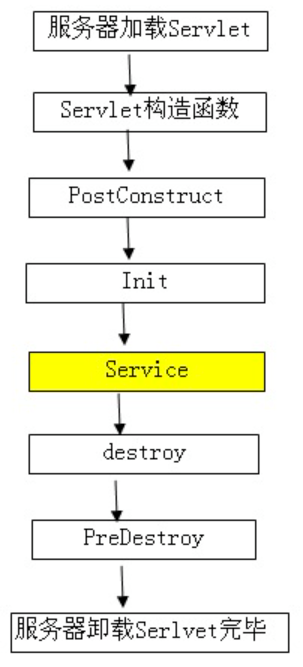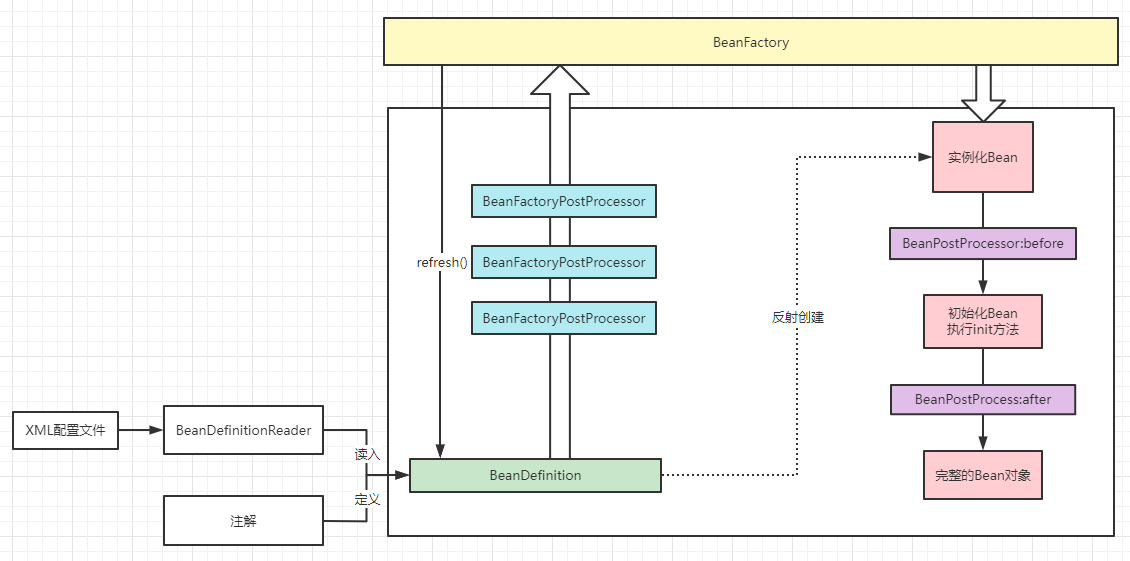spring IOC
spring IOC
生命周期
Spring 注册BeanDefintion时序图

初始化回调
实现
org.springframework.beans.factory.InitializingBean接口里的void afterPropertiesSet() throws Exception;方法。使Bean执行初始化工作。建议您不要使用该InitializingBean接口,因为它不必要的将代码耦合到Spring<bean id="exampleInitBean" class="examples.AnotherExampleBean"/>public class AnotherExampleBean implements InitializingBean { @Override public void afterPropertiesSet() { // do some initialization work } }在基于 XML 的配置元数据的情况下,可以使用该
init-method属性来指定具有无效无参数签名的方法的名称。(没有将代码耦合到 Spring)<bean id="exampleInitBean" class="examples.ExampleBean" init-method="init"/>public class ExampleBean { public void init() { // do some initialization work } }建议使用
@PostConstruct注解@PostContruct是Java自带的注解,在方法上加该注解会在项目启动的时候执行该方法,也可以理解为在spring容器初始化的时候执行该方法。从Java EE5规范开始,Servlet中增加了两个影响Servlet生命周期的注解,@PostConstruct和@PreDestroy,会在服务器加载Servlet时候运行,并且只会被服务器执行一次。PostContruct在构造函数之后,init()方法之前执行。这两个注解被用来修饰一个非静态的void()方法。
import org.springframework.beans.factory.annotation.Autowired; import org.springframework.stereotype.Component; import javax.annotation.PostConstruct; @Component public class MyUtils { private static MyUtils staticInstance = new MyUtils(); // 自己定义的类,注入进来 @Autowired private MyMethorClassService myService; @PostConstruct public void init(){ // 想在生成对象时完成某些初始化操作,这些初始化操作又依赖于依赖注入。就无法在构造函数中实现,为此可以使用@PostConstruct注解一个方法完成初始化 staticInstance.myService = myService; } public static Integer invokeBean(){ return staticInstance.myService.add(10,20); } }@PostConstruct注解的方法将会在依赖注入完成后被自动调用。Constructor >> @Autowired >> @PostConstruct
貌似得扩展下Servlet的部分知识:

销毁回调
实现该
org.springframework.beans.factory.DisposableBean接口的void destroy() throws Exception;可以让 bean 在包含它的容器被销毁时获得回调。(建议您不要使用,因为它不必要地将代码耦合到 Spring)<bean id="exampleInitBean" class="examples.AnotherExampleBean"/>public class AnotherExampleBean implements DisposableBean { @Override public void destroy() { // do some destruction work (like releasing pooled connections) } }使用基于 XML 的配置元数据,您可以
destroy-method使用<bean/><bean id="exampleInitBean" class="examples.ExampleBean" destroy-method="cleanup"/>public class ExampleBean { public void cleanup() { // do some destruction work (like releasing pooled connections) } }在方法上加上@PreDestroy注解
@PostConstruct //方式1 public void someMethod(){ ... } public @PostConstruct void someMethod(){ //方式2 ... }
控制反转流程
Spring如何管理Bean的,如下Spring生成一个Bean的流程 
BeanPostProcessor接口定义了您可以实现的回调方法,以提供您自己的(或覆盖容器的默认)实例化逻辑、依赖关系解析逻辑等。如果你想在 Spring 容器完成实例化、配置和初始化 bean 之后实现一些自定义逻辑,你可以插入一个或多个自定义BeanPostProcessor实现。
BeanPostProcessor实例对 bean(或对象)实例进行操作。也就是说,Spring IoC 容器实例化一个 bean 实例,然后BeanPostProcessor实例完成它们的工作。
BeanPostProcessor实例的范围是每个容器。这仅在您使用容器层次结构时才相关。如果您BeanPostProcessor在一个容器中定义 a,它只会对该容器中的 bean 进行后处理。换句话说,在一个容器中定义的 bean 不会被另一个容器中定义的 bean 进行后处理BeanPostProcessor,即使两个容器是同一层次结构的一部分。要更改实际的 bean 定义(即定义 bean 的蓝图),您需要使用 a
BeanFactoryPostProcessor
BeanPostProcessor示例:
一个示例说明了基本用法。该示例显示了一个自定义 BeanPostProcessor实现,该实现调用容器创建的每个 bean 的toString()方法,并将结果字符串打印到系统控制台。
package scripting;
import org.springframework.beans.factory.config.BeanPostProcessor;
public class InstantiationTracingBeanPostProcessor implements BeanPostProcessor {
// simply return the instantiated bean as-is
public Object postProcessBeforeInitialization(Object bean, String beanName) {
return bean; // we could potentially return any object reference here...
}
public Object postProcessAfterInitialization(Object bean, String beanName) {
System.out.println("Bean '" + beanName + "' created : " + bean.toString());
return bean;
}
}
<?xml version="1.0" encoding="UTF-8"?>
<beans xmlns="http://www.springframework.org/schema/beans"
xmlns:xsi="http://www.w3.org/2001/XMLSchema-instance"
xmlns:lang="http://www.springframework.org/schema/lang"
xsi:schemaLocation="http://www.springframework.org/schema/beans
https://www.springframework.org/schema/beans/spring-beans.xsd
http://www.springframework.org/schema/lang
https://www.springframework.org/schema/lang/spring-lang.xsd">
<lang:groovy id="messenger"
script-source="classpath:org/springframework/scripting/groovy/Messenger.groovy">
<lang:property name="message" value="Fiona Apple Is Just So Dreamy."/>
</lang:groovy>
<!--
when the above bean (messenger) is instantiated, this custom
BeanPostProcessor implementation will output the fact to the system console
-->
<bean class="scripting.InstantiationTracingBeanPostProcessor"/>
</beans>
BeanFactoryPostProcessor示例
org.springframework.beans.factory.config.BeanFactoryPostProcessor,BeanFactoryPostProcessor对 bean 配置元数据进行操作。也就是说,Spring IoC 容器允许BeanFactoryPostProcessor读取配置元数据并可能在容器实例化除实例之外的任何 bean之前BeanFactoryPostProcessor更改它。